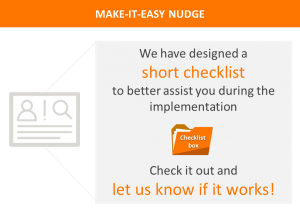Behavioral change management
This case study shows how behavioral insights can assist change management and organizational transformation. It builds on a real-world challenge, while the solution and the underlying data are illustrative examples only. [1]
Behavioral root causes: What are the key challenges?
Many organizations face significant challenges during times of transformation and change. Employees often respond to change with resentment, disregard the need to transform or are overwhelmed by new rules and regulation.
Whether denial, demotivation, fear, or anger – changes put people under emotional stress with severe consequences for organizational performance and output. How can behavioral insights help to manage change and involve employees in the right way?
Behavioral design: How can compliance with new rules and regulations be fostered?
In this case study, we give a brief outlook into behavioral change management. The case refers to a production company which needs to inform workers at 12 different locations about new operating processes. The new processes need to be communicated by help of salient posters. Their content is already prepared but the leadership is concerned that “just informing” will not be enough to mobilize compliance.
The task is to enhance the posters in a way that makes workers comply with the new operating processes as quickly as possible. Here are three possible nudges to support the information campaign and boost compliance.
1. Option: Make-it-relevant nudge
What if workers think the new procedures do not apply to them or that a little delay will be of no harm? In that case, workers may postpone reading the content of the posters to avoid the learning effort. This effect can be countered by highlighting the relevance of the new procedures. A common nudge approach is to illustrate the cost of a delayed implementation. These nudges help workers to better understand the bigger picture and the consequences of non-compliance.
2. Option: Make-it-social nudge
People like to comply with the norms of their peer groups. Workers who believe that their colleagues will not implement the new procedures might thus be afraid of being seen as outsiders. A nudge to reinforce a better social norm may help. Social nudges inform workers who would like to comply that they are in good company and hence correct a false consensus. They are especially powerful when the leadership expects that performance will vary across teams or production sites.
3. Option: Make-it-easy nudge
Even if workers want to implement the new procedures instantly, they might still fail to do so because they forget some of the details or fall back to their original routines. For that reason, many organizations provide their staff with “mental walkers” to assist habit formation. A widely used technique is the provision of handy checklists. Instead of recalling the new procedures from memory, workers follow the step-by-step instructions provided by the checklist. After a few days, new habits are formed and workers do not need to concentrate on the new task anymore.
Behavioral pilot: Which nudge fits best to your workforce?
To learn which option works best for the workers, let us assume that the leadership wants to test the nudges during a pilot phase under real-world conditions. Production sites would be assigned to the make-it-relevant, make-it-social, or make-it-easy nudge. A fourth site would be selected to serve as benchmark. Workers at this facility receive the original posters without any nudges.
Once the pilot data is collected, compliance rates under the four conditions can be analyzed.
Evaluation: What’s in it for the organization?
The exemplary data above suggests that all three nudges improve compliance with the new procedures. The make-it-relevant nudge would increase compliance rates by 1.7%, the make-it-social nudge by 3.1% and the make-it-easy nudge by 4.7%.
This does not sound like large effects? Then let us have a look at the potential savings. With 12 locations and approx. costs of EUR 500,000 for every day of delay, the next figure shows how the remaining days to achieve full compliance would translate into costs to the business.
The costs for lagged compliance would considerably decrease when nudges are used: 13.1% (EUR 816k) would be saved with the make-it-relevant nudge, 23.3% (EUR 1,450k) with the make-it-social nudge and 34.9% (EUR 2,168k) would be saved when the make-it-easy nudge is used to support the change management efforts.
Key takeaway
Small changes, large impact – this is what behavioral insights have to offer for change management. The added value of (almost) zero-cost nudges arises from small improvements to routine and repetitive tasks that translate into major cost savings on the aggregate level.
If you are interested in behavioral change management, please get in touch with us. We are always excited to learn more and help if we can.
[1] Behavia makes no warranty, representation or undertaking whether expressed or implied, nor does it assume any legal liability, whether direct or indirect, or responsibility for the accuracy, completeness, or usefulness of any information presented in the case study.




